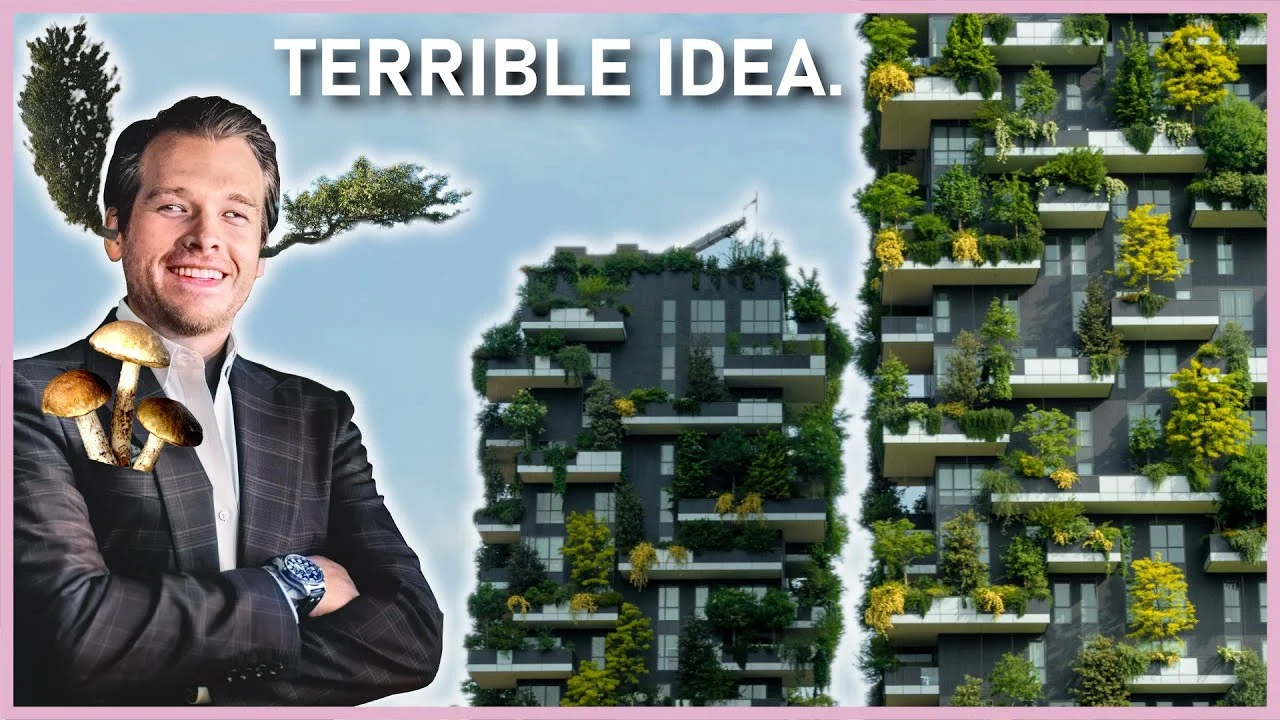“Because green skyscrapers and high-rises are a bullshit non-solution to serious systemic problems.”
“But if you want greenery on a building nonetheless, do I have an idea for you – a portable, modular, scalable solution called ‘potted plants on your balcony’.”
The reality is plants are beautiful and greenery is good for the environment. So as long as you do not put literal trees on a building it should be fine. Also modern tall buildings have cranes on top for facade work, window cleaning and so forth. So caring for plants is certainly possible. Also those green skyscrapers basically have potted plants on them as well.
Plants also come with a lot of benefits. They cool the building when it needs cooling by providing shade and water. If you are in a colder climate and the plants you choose loose their leaves, they even allow sunlight on the facade, when heating is most needed, while shading it in summer. Plants like wine, which can easily be green on facades have useful fruits. As do many fruit trees, which can be grown from the ground floor in espalier fashion.
Then we have roof gardens, which only have been in use since 600BC or so. They work and are nice.
Also really import everybody has to look at a building and especially when you are building tall, they should make sure the building is beautiful. Plants are beautiful and are a great option for decoration.
So much of this video hinges on the assumption that if you have greenery on buildings, you can’t also have greenery on the ground. Sure, in an ideal world, you can use the fact that greenery on the ground is easier to maintain to guide priorities. In this current less-than-ideal world though, the city owns the road and a private developer owns the building and neither side can really force the other to add greenery.
It’s always about the money. And if you are building a high building chances are you don’t have acres around. And like you say, the solution is not building a dumbass vertical garden, it’s politics. Green the city because you as a citizen should force the city to be good
limited budget – you can pay for structural changes and maintenance costs to put greenery on the building or you can use that same money for a lot more greenery at street level where it benefits a lot more people
I just like the idea. It don’t solve anything. However more greenery is better than less.
Sucks up pollution. Hells with depression. Hells with pollinators and bugs. Can’t really see a downside
Can’t really see a downside
The downside is almost certainly structural (significant weight as well as moisture, and a need for long term structural integrity and safety, likely don’t pair well. Especially not when the people doing the building are looking for cost effectiveness).
If you don’t build with cardboard this problem is very easy to solve, its called putting a goddam Pond liner between the dirt and the structure itself.
And the weigh isn’t a issue with low buildings, say 10 to 20 floor that aren’t made from cardboard, and higher than that is inefficient in all regards anyway and should be avoided.
its called putting a goddam Pond liner between the dirt and the structure itself.
lol, sure, that sounds super fucking safe… 🙄
I suggest you look in to building regulations and how developers do their utmost to circumvent them before you speak with such confidence about something you clearly know nothing about… fucking pond liner smmfh… 😂🤦♀️🤦♀️🤦♀️
Idk the English word for it, but there is a kind of foil that is water resistant and where roots cant go through, as long as its not a tree or something at least. Its put between the foundation and the walls to stop water from below.
Pond liner is just what the translator got out, its probably incorrect.
Also im talking about this

Not planting literal trees on balconys, that would be a structural problem, yes. But small shrubs and Twiners would do the trick as well if not better in regards of cooling and weight. They also don’t need much soil or and significantly less water.
Also can you stop spamming emojis?
Lmmfao
“spamming emojis”… 😂
Get over yourself
🖕🖕🖕🖕🖕🖕🖕🖕🖕🖕🖕🖕🖕🖕🖕🖕🖕🖕🖕🖕🖕🖕🖕🖕🖕🖕🖕🖕🖕🖕🖕🖕🖕🖕🖕🖕🖕🖕🖕🖕🖕🖕🖕🖕🖕🖕🖕🖕🖕🖕🖕🖕🖕🖕🖕🖕🖕🖕🖕🖕🖕🖕🖕🖕🖕🖕🖕🖕🖕🖕🖕🖕🖕🖕🖕🖕🖕🖕🖕🖕🖕🖕🖕🖕🖕🖕🖕🖕🖕🖕🖕🖕🖕🖕🖕🖕🖕🖕🖕🖕🖕🖕🖕🖕🖕🖕🖕🖕🖕🖕🖕🖕🖕🖕🖕🖕🖕🖕🖕🖕🖕🖕🖕🖕🖕🖕🖕🖕🖕🖕🖕🖕🖕🖕🖕🖕🖕🖕🖕🖕🖕🖕🖕🖕🖕🖕🖕🖕🖕🖕
🤣🤣🤣Oh, and it doesn’t matter what you call it, the thing you’re talking about isn’t a solution (not only, as you say yourself, is it only “suitable” for bare minimum greenery, so not even relevant to the discussion about proper plants growing on buildings, it also doesn’t actually do that good a job, I suggest as well as looking up building regulations, you look up what walls look like, but more importantly in what poor condition it is under that crap once it’s taken/falls off, and how many architects and builders despise the stuff).
So to recap - get over yourself, doubling down on being wrong, however confidently, won’t suddenly make you right, nor will criticising the use of emojis because you have a stick so far up your ass you can’t even bend over lmfao (here’s a hint though: the less of an ass you are, the less likely people are to post laughing emojis at you)
🤷♀️
😂😂😂
How heavy do you think plants are ? Heavier than furniture? Or just fat humans ?
Water is heavy, and plants are made of mostly water.
Ok. Is water heavier than steel ? I think most buildings can support a bunch of plants
The issue I was trying (and failing) to get at is the additional weight the building now has to support on top of everything else a building normally has to support. However, it doesn’t seem to be a big deal judging by everyone’s replies.
I have no idea. Not an architectural engineer.
My assumption would be that they have to build the building to a code that has a minimum weight requirements.
Male Humans are generally averaging about 80kg.
If you have a party and have 10 - 15 over. That’s a lot of weight. Not all the time but I think if every apartment had a few plants then the weight would still be less than having a party.
Or that was my assumption anyway. I know balconies have a weight limit, as there was a story about a party and too many people were out on it and it collapsed
Short info https://www.bbr-server.de/bauarchivddr/archiv/dokumente/3-4-17-wohnungsbauserie-wbs70.pdf
The blueprints https://bauarchivddr.bbr-server.de/bauarchivddr/archiv/dokumente/3-4-01-2-wohnungsbauserie-wbs-70-6-3-t.pdf
This is the blueprints of a pre modern apartment building (its in German but you could use chat pdf if you need translation) more modern buildings use these as basis (modified versions of course) as these block buildings are modular, cheap, very resistant and reliable. They can definitely support the extra weight of some plants on the facade, nobody wants to plant trees on the building, that wouldn’t necessarily be a weight problem but rather a problem with the roots damaging the building, and you can’t really stop tree roots, maybe some smaller trees but definitely not Oaks or Fruit trees.
That’s awesome, thanks for the info!
Seems to work out OK for Singapore
Singapore can afford to throw money at a problem until it goes away …
Developers in Singapore have to make money too. Buildings are built by the market not the state
I insists these are great, and not a solution to anything (the green thing is just marketing). Basically a form of fasade, the look of things etc.
And regarding implementation, they are just dog shit bad bcs often neither contractors nor architects are incentivized to spend time & money on it (they get most of their moneys by selling, not maintaining).
But there are solutions that were properly implemented and work all over the world. Even as retrofits to old buildings. Or to cover up outside walls where there aren’t any windows for various reasons.
And also, most (green or non-green) highrises have some leaks, it’s basically just a big complicated block that is bound to have imperfections.
And also 2, big core systems implemented have to be maintained as designed. Just like sprinkler systems have to be inspected and tested by law. Eg if we stop maintaining our air ventilation system (with filtration, humidification, and some pre-heating/cooling) I bet we get bacteria and fungi (maybe invertebrates) pumped around the building.









